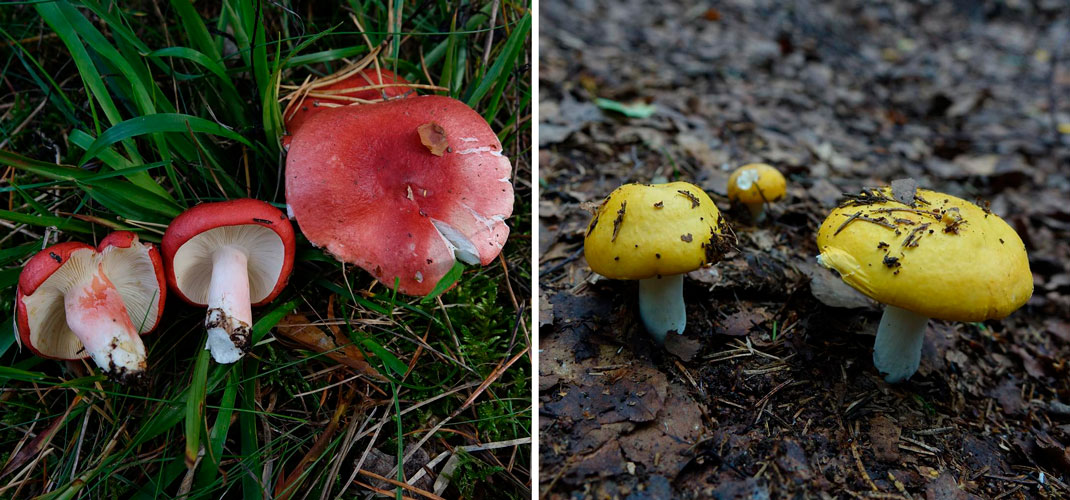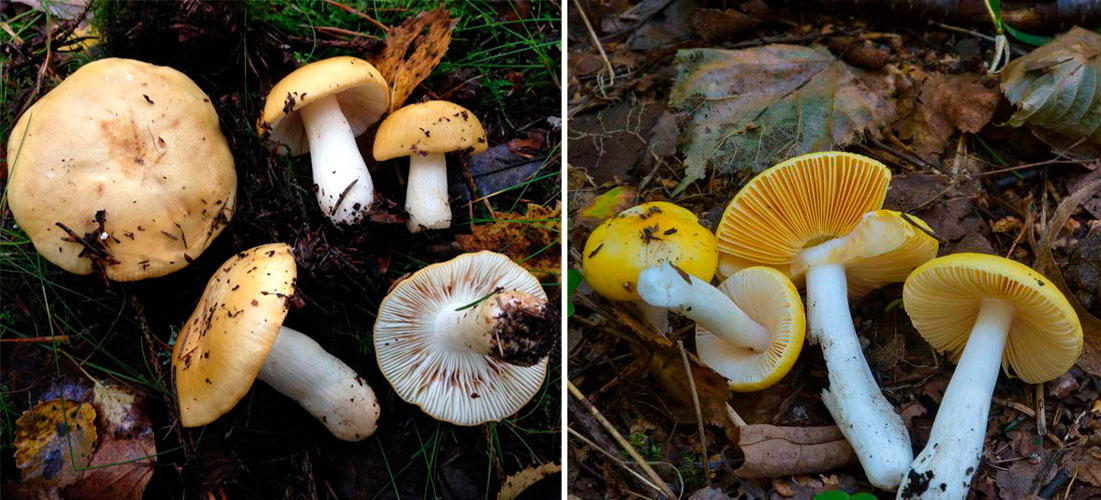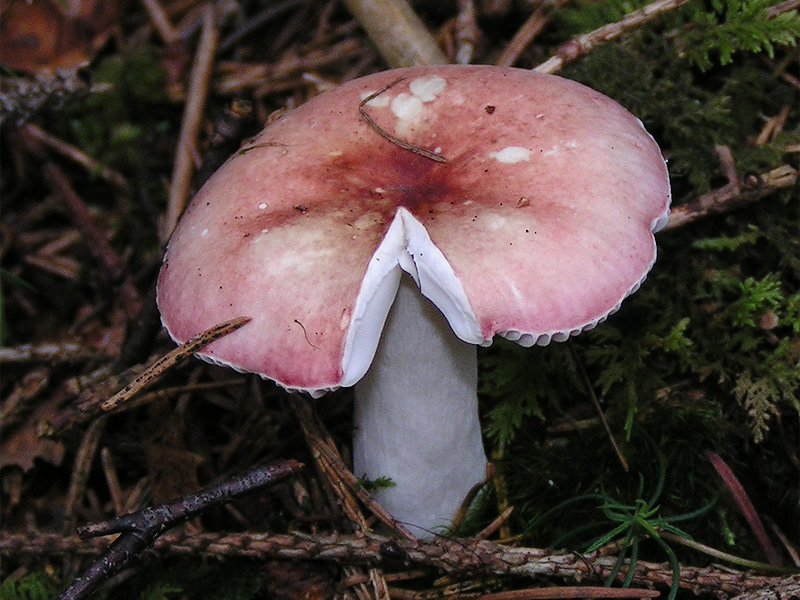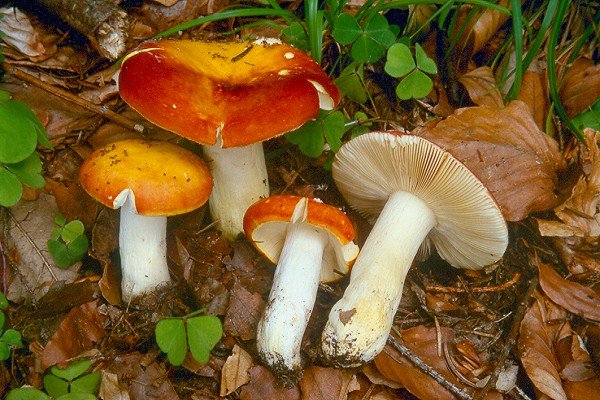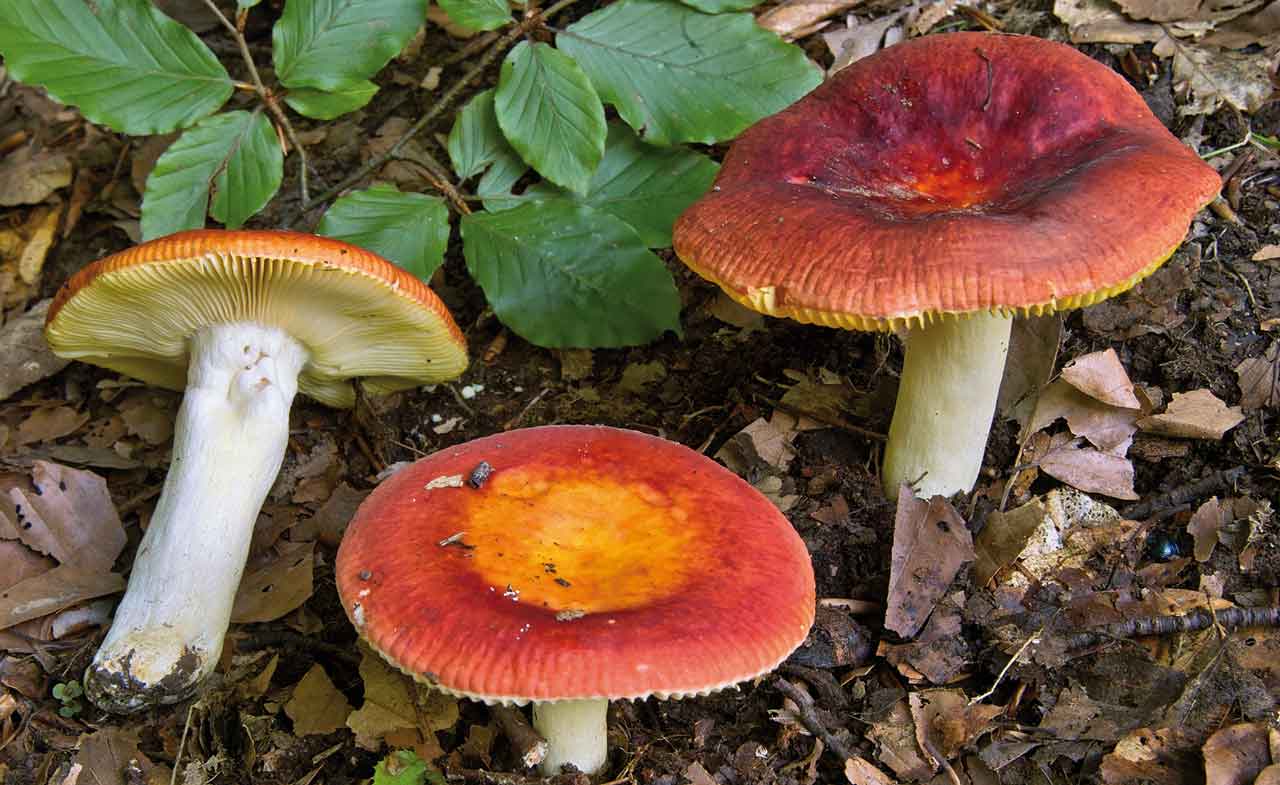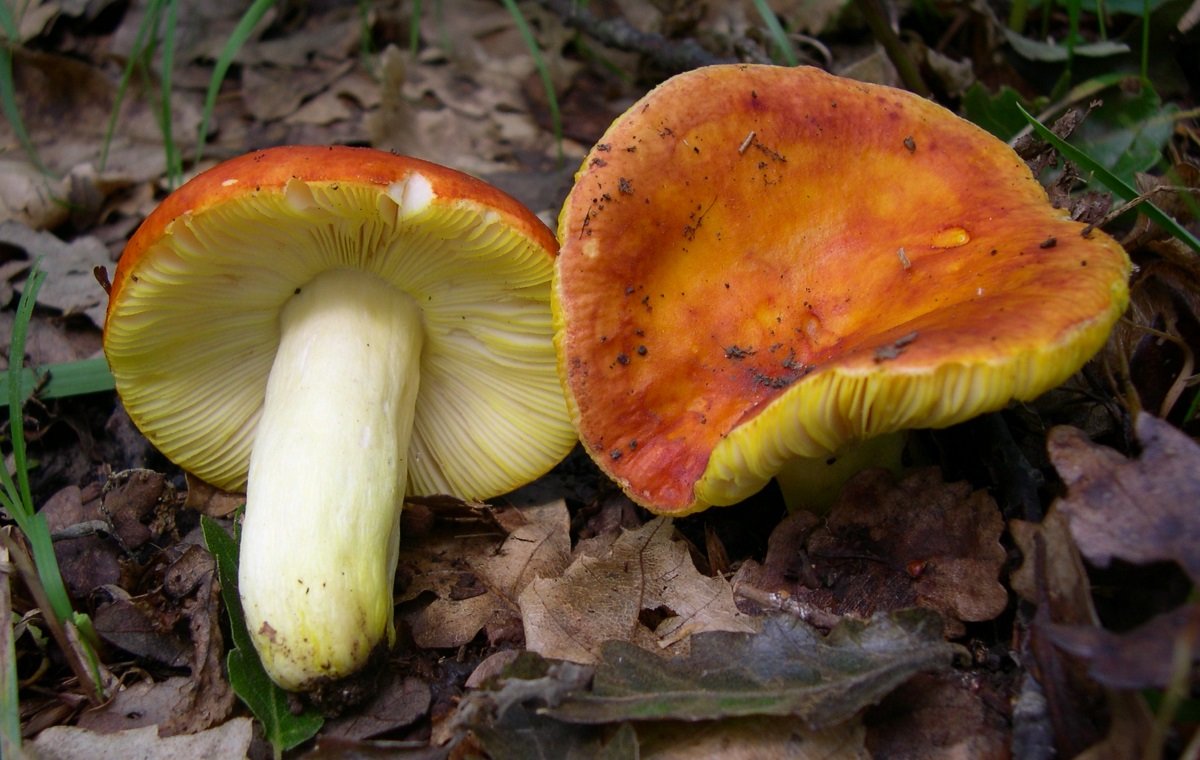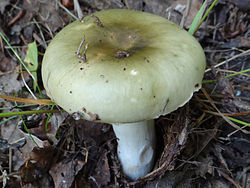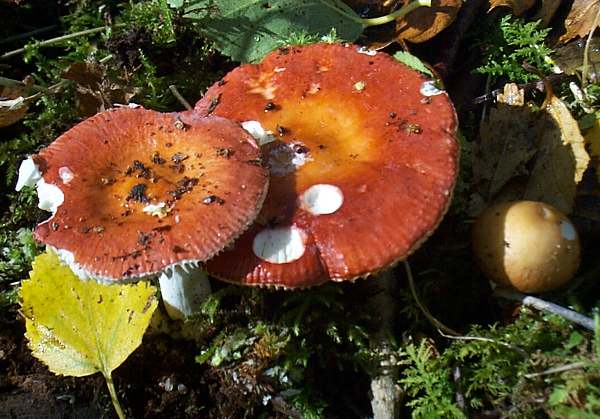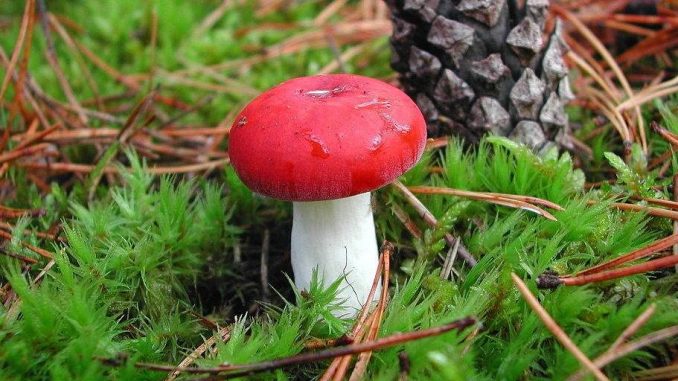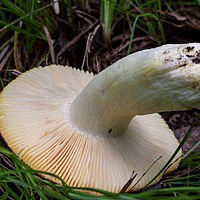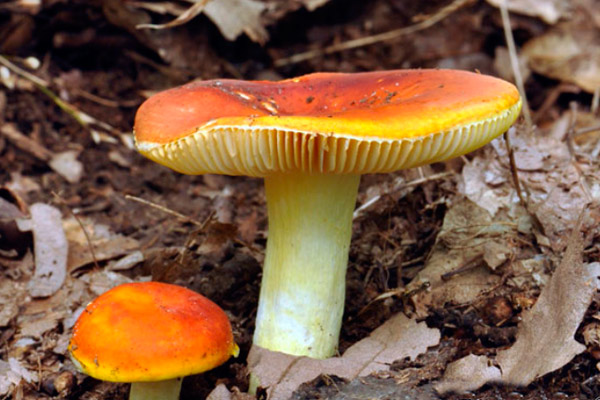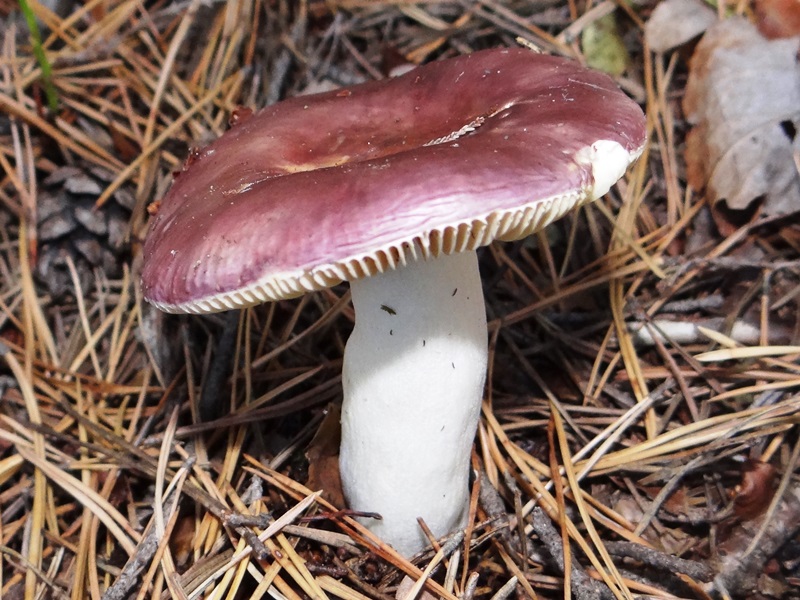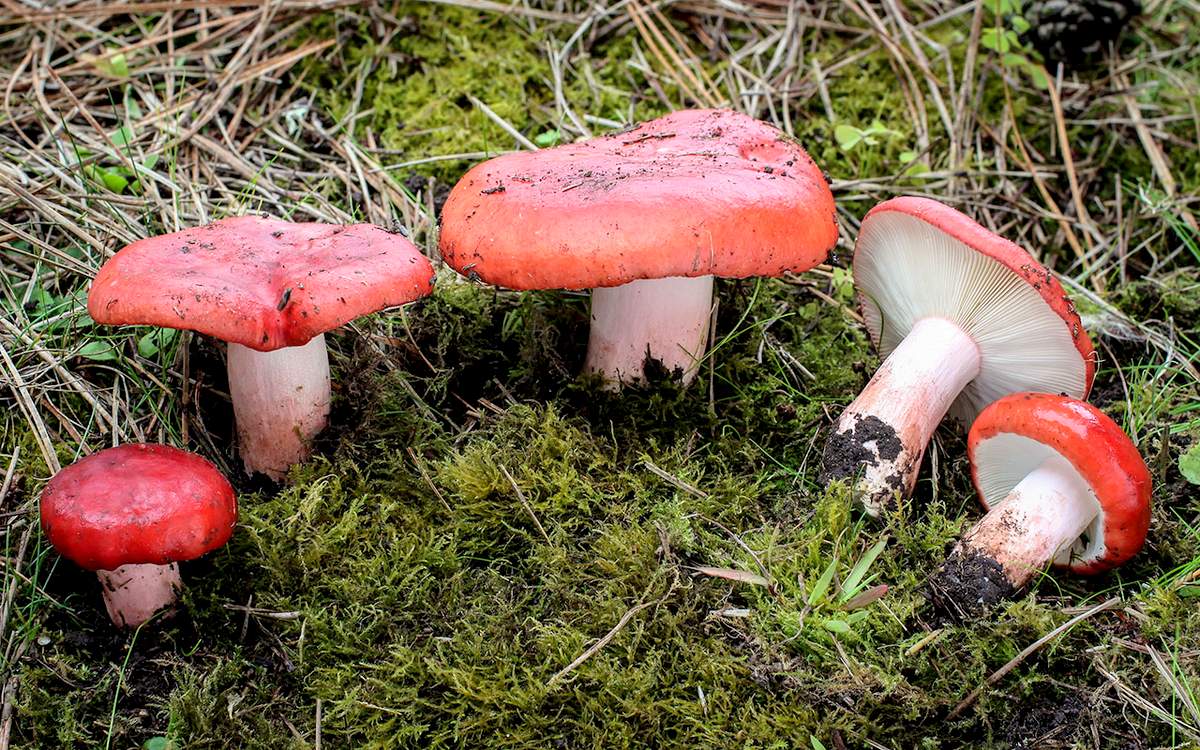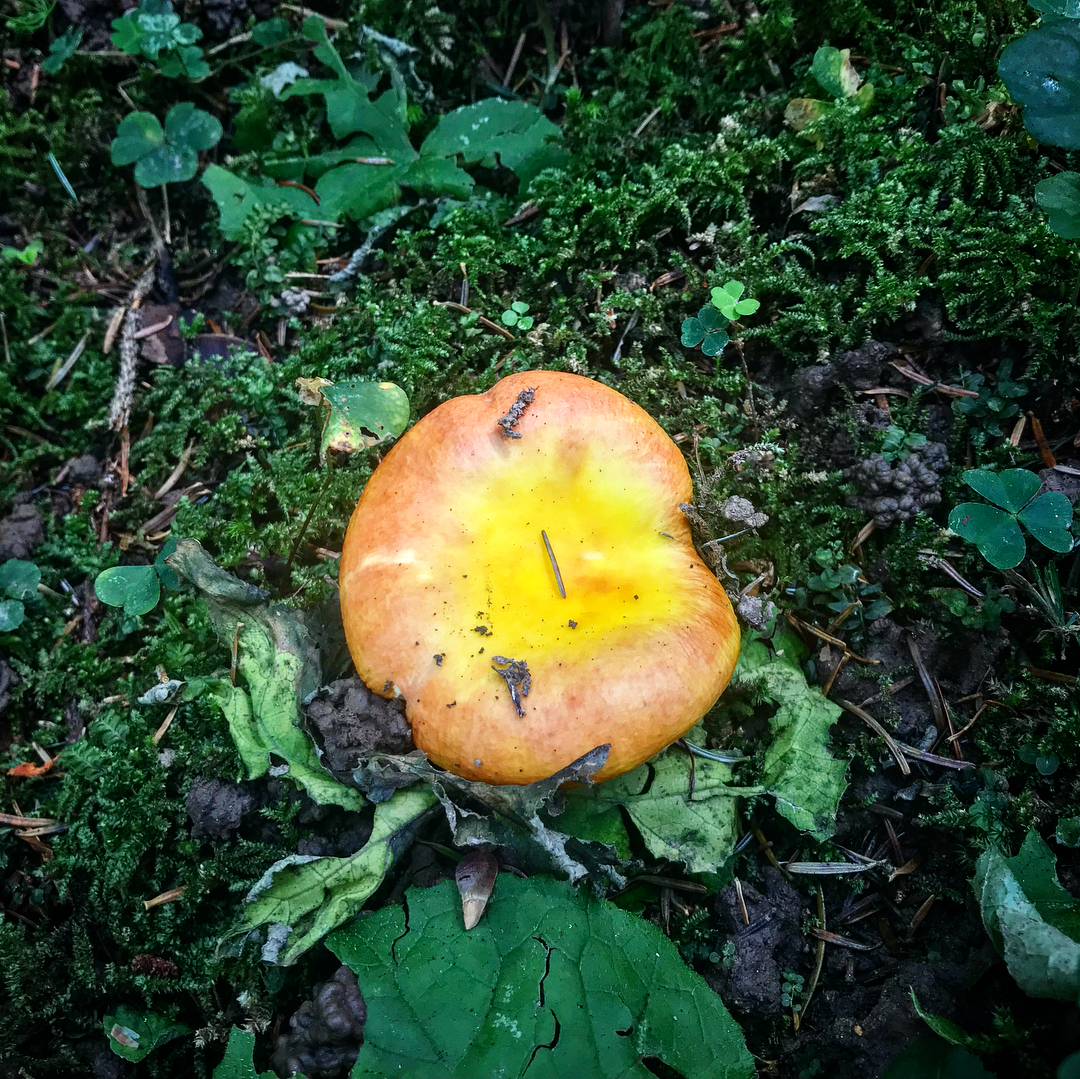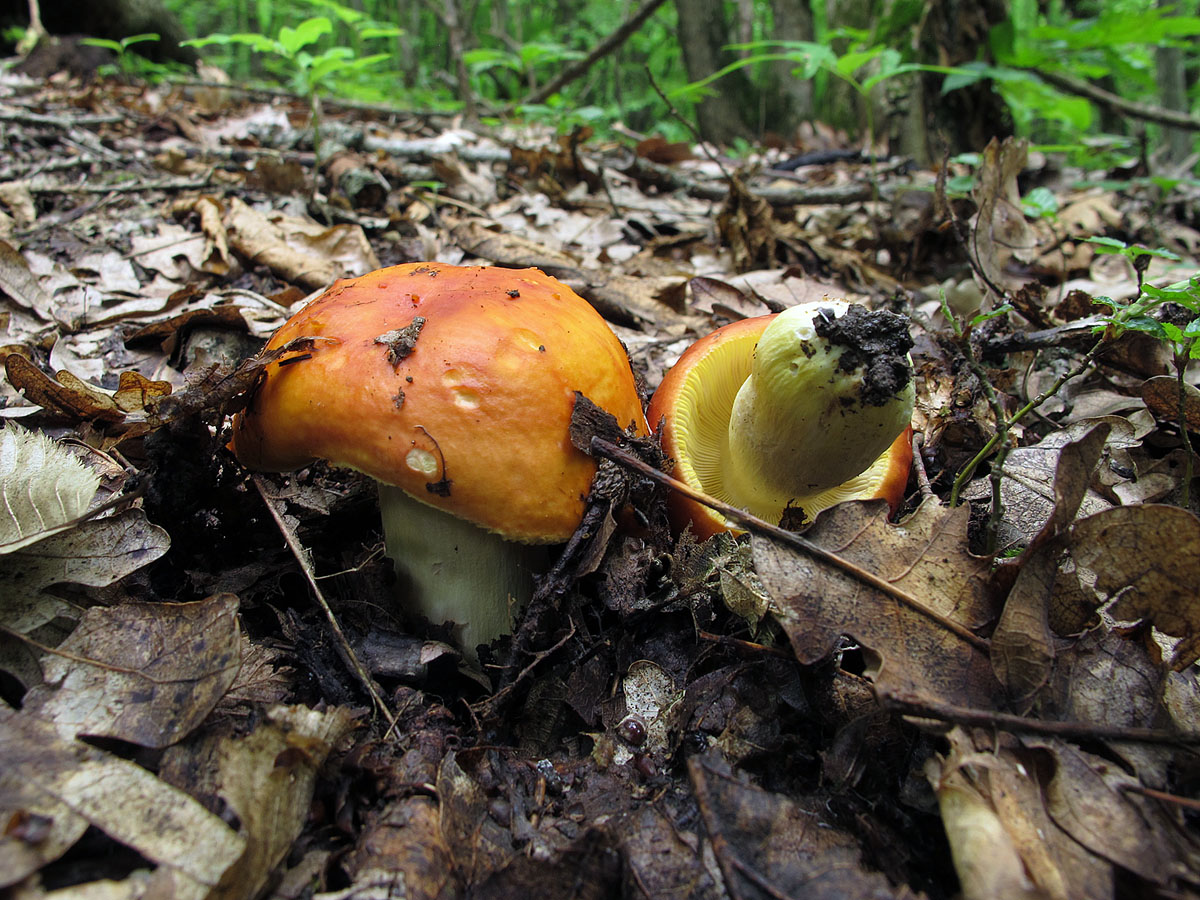Mayra's russula (Russula nobilis)
Other names:
- Russula fageticola;
- Russula fagetorum.
External description
Mayra's russula has a cap-toed fruiting body, with dense white flesh, which may have a slightly reddish tint under the skin. The pulp of this mushroom is characterized by a pungent taste and aroma of honey or fruit. Upon contact with a solution of guaiacum, it intensively changes its color to a brighter one.
The cap of Mayr's russula is 3 to 9 cm in diameter, and has a hemispherical shape in young fruiting bodies. As the mushroom matures, it becomes flat, sometimes slightly convex or slightly depressed. The color of the cap in Mayr's russula is initially deep red, but gradually fades, becoming reddish-pink. The skin adheres tightly to the surface of the cap and can only be removed at the edges.
The leg of Mayr's russula is characterized by a cylindrical shape, very dense, often white in color, but at the base it can be brownish or yellowish. The fungal hymenophore is represented by the lamellar type. The plates in its composition at first have a whitish color, in mature fruiting bodies they become creamy, often grow with the edges to the surface of the leg.
Fungal spores in Mayr's russula are 6.5-8 * 5.5-6.5 microns in size, have a well-developed mesh. Their surface is covered with warts, and the shape is obovate.
Season and habitat of the mushroom
Mayr's russula are widespread throughout southern Europe. You can meet this species only in deciduous beech forests.
Edibility
Mayr's russula is considered a slightly poisonous, inedible mushroom. Many gourmets are repelled by the bitter taste of the pulp. When consumed raw, it can provoke not severe poisoning of the gastrointestinal tract.
Similar types and differences from them
Mayr's russula has several similar species:
1. Russula luteotacta - this type of mushroom can be found mainly in hornbeams. Distinctive features of the species are spores of a non-reticular structure, the pulp, which acquires a rich yellow color when damaged, weakly descending down the pedicle of the plate.
2. Russula emetica. This type of mushroom is found mainly in coniferous forests, has a rich color of the cap, the shape of which becomes funnel-shaped with age.
3. Russula persicina. This species grows mainly under beeches, and its main distinguishing features are cream-colored spore powder, reddish stem and yellowish plates in old mushrooms.
4. Russula rosea. This type of mushroom grows mainly in beech forests, has a pleasant taste and a reddish stem.
5. Russula rhodomelanea. This fungus grows under oak trees and is characterized by sparsely spaced blades. Its pulp turns black when the fruit body dries.
6. Russula grisescens. The fungus grows in coniferous forests, and its pulp turns gray upon contact with water or high humidity.
Mycelium Golden-red Russula (Russula golden), Russula aurata
Description
Russula golden-red (Russula golden), lat. Russula aurata is a mushroom of the genus Russula (Russula) of the family Russulaceae. The mushroom is lamellar, has a pronounced cap and leg. The cap of young bell-shaped mushrooms, later becomes completely flat, with small depressions. The surface is free of mucus, the skin is well separated from the pulp. Plates are even, often located, ocher color. In many specimens, the edges of the plates have a bright yellow color. The color of the cap itself can be different - yellow, brick, red, with a purple tint. The leg of a russula of this type is dense, numerous scales are located on the surface. The color is creamy, in older mushrooms it can be brown. The structure of the pulp is dense, odorless, tastes slightly sweet. There is no bitterness. The lumpy spores of Russula aurata have ribs that form a mesh. The growing area is very large, the fungus is found everywhere in the forests of Europe, Asia, and North America. It prefers to grow in small groups. Perfectly cultivated! Our mycelium is intended for sowing mushrooms at home, healthy, high quality, has good germination!
There are two types of mycelium of forest mushrooms: 1. Mycelium (mycelium) live fresh primary grain packed in a transparent blister / zipper measuring 8x12x3cm and weighing 120-150 grams (depending on the humidity of the environment; after all, it is alive, develops, breathes, gains and loses moisture). Shelf life is 6 months. at a temperature of + 2 + 6 ° С or 1 month at temperatures up to + 23 ° С without direct sunlight. It can withstand a higher temperature for 10 - 14 days, if the packages are not tightly in contact with each other. 2. Mycelium (mycelium) biologically dried primary grain 100g in a transparent blister / zipper package 8x12x3cm. The shelf life is not limited.
INSTRUCTIONS FOR CULTIVATION OF FOREST MUSHROOMS Planted in gardens, parks, forests, nurseries, greenhouses, flower beds, lawns, etc. area 2.5 - 3m2. Fluff the ground under the tree so that a depression of 5 - 15 cm is formed, depending on the location of the roots at the soil surface. Spread the mycelium evenly over the entire fluffed surface. Cover with garden (or forest) soil, mixed with any humus, in equal parts. Sprinkle on top with the soil that was formed during fluffing with a deepening. Planting can be done at any time of the year and under any species of trees. Watering is carried out in dry times, often with a garden watering can or in another way, about 10 liters per 1 m2. Mushrooms appear in spring and autumn, but for the first time not earlier than 5 months after planting. Sometimes the first harvest can be only the next year. The first harvest is 350 - 500 g / m2, the next 3.5 - 4.5 kg / m2. Mycelium grows for many years, as long as the tree lives. All forest mushrooms can be planted together with tree seedlings. Spread the mycelium, for example, russula or milk mushrooms, well, or any others, evenly over the bottom of the hole prepared for planting a seedling, and then continue planting plants as usual. It is recommended to grow a chanterelle next to any forest mushrooms! Chanterelle is widely used both in folk medicine and in traditional official pharmacology. This mushroom contains many substances that not only determine its medicinal properties, but also actively fight against fungal diseases, harmful molds that interfere with the normal development of mycelium, mushroom worms, etc. Chanterelles themselves almost never worm themselves (there is one type of worms that eat them, but I personally have never seen them) and nearby mushrooms can grow to gigantic sizes without worming either. The mycelium of the chanterelle, as it were, “prepares” the place for the development of the mycelium of the titular fungus, and then zealously “takes care of” it for many years. Next to the chanterelles, porcini mushrooms, boletus mushrooms, aspen mushrooms, Polish mushrooms, boletus, like everyone else, feel great!
Indoors, you can try to grow mushrooms in the same way as champignons, only by sowing any perennial grass. The results of growing will be slightly worse than in an open area, but it is really possible. More detailed instructions (+ instructions for growing and other mushrooms by species) in the brochure will be sent along with the order. Free consultations after the sale before the appearance of the first mushrooms when ordering from 5 packs. Mycelium will be sent after partial or full payment. With 100% payment - a bonus from the manufacturer!
Application of russula golden
This type of mushroom is widely used in cooking. Roast is prepared from them, side dishes, pickled, salted, dried for future use.
Before cooking, it is recommended to pour the mushroom over with boiling water to make the pulp more elastic and maintain its shape, especially if it will be pickled or rolled in jars. Tasty russula stewed in sour cream sauce are obtained. They can be used to make pies and pizza toppings. You can eat salted russula the next day. They can also be rolled into banks and harvested for the winter.
There is another way of harvesting for future use - this is drying. Each russula is washed, dried and strung on threads, then hung in a dry, warm room. Thus, the mushroom gradually shrivels and dries out, but at the same time retains all the taste qualities and even enhances them. Subsequently, delicious mushroom broths and soups can be cooked from such a blank.
The process of cooking the golden russula does not take much time: it is enough to boil it once for half an hour and add it to any dish. Before cooking, the golden russula is recommended to be soaked in water and left overnight or soaked in liquid for a couple of hours.
Signs of poisoning with a false russula
Toxicologists divide mushroom poisoning into 4 types. False russula is dangerous with poisonous milky juice, therefore it belongs to group 4.
The picture of poisoning by stages is as follows:
- A maximum of 6 hours after consumption, a person weakens, he begins to have diarrhea, nausea and vomiting.
- Within 2 days, symptoms of a gastrointestinal disorder are clearly manifested.
- Then the poison leaves the body and the patient recovers.
Fatal outcomes from the use of false russula have not been recorded. However, the symptoms of poisoning are unpleasant, so eating inedible mushrooms is not worth it.
When collecting russula, always pay attention to their color, shape and smell. Outwardly attractive mushroom can be hazardous to health
It is better to once again make sure of the correctness of the choice than to drink medicine and suffer later.
A competent mushroom picker always carefully collects the forest harvest, so as not to harm himself and his loved ones
Russula golden
| Group: | Lamellar |
|---|---|
| Plates: | White, yellowish |
| Colour: | Shades of red |
| Info: | Scales on the leg |
| Department: | Basidiomycota (Basidiomycetes) |
|---|---|
| Subdivision: | Agaricomycotina (Agaricomycetes) |
| Class: | Agaricomycetes (Agaricomycetes) |
| Subclass: | Incertae sedis (indefinite) |
| Order: | Russulales |
| Family: | Russulaceae (russula) |
| Genus: | Russula (Russula) |
| View: | Russula aurea (Russula golden) |
The mushroom is edible, assigned to the 3rd category, has a pleasant taste. It is appreciated above most types of russula. You can use it fresh or salted.
Description
Russula golden received its specific name due to the clear yellow subtone of the color of the entire fruit body.
Hat
The size of the cap varies from 4 to 9 cm in diameter. With maturation, its shape changes from hemispherical to flat and then centrally depressed. Young specimens have smooth edges, and old ones are striated (a layer of hymenophore appears).
The color of the cap is of all shades of red, and at a young age, red color predominates in mushrooms of this species, and yellowness appears more and more in maturity. The central cap is almost always colored in shades of yellow. The surface is variable to the touch depending on humidity: in the absence of precipitation - dry, in rainy weather - sticky.
Leg
The russula golden has an even-cylindrical stem with a rough-scaly surface. The leg is painted white, sometimes yellowish, and turns brown in mature mushrooms. Inside, the leg never contains a cavity and has a cotton-like consistency. In mature mushrooms, it acquires a distinct porosity. The dimensions of the leg are from 3 to 8 cm in height and from 1 to 2 cm in thickness.
Spore powder
The spores are egg-shaped and fairly large. Their surface is bumpy and reticulate. The bulk of the spore powder is white.
Spore-bearing layer
The plates are of moderate thickness, can be located both often and not very much. Multiple bifurcation of the plates is usually observed. Their color is initially white, but in the process of maturation it quickly turns yellow. The plates are not attached to the leg.
Pulp
Initially hard and crumbly, in mature specimens it becomes softened and “wadded”. Directly under the easily detachable skin of the cap, the flesh is yellow, and in the rest of the mushroom it is white. The pulp does not emit any smell and has a pleasant sweet taste.
Distribution and collection
The golden russula, with a fairly widespread prevalence (practically over the entire Eurasian and North American territory), is not very common. This species grows mainly in deciduous forests all summer and the first month of autumn.
Similar species
There are several types of russula, resembling golden in appearance:
This mushroom has a very strong pulp and red shades of the cap, which do not turn yellow with age. The pulp has a distinctly fruity smell, and when heat-treated it is turpentine, and therefore the species is not considered edible. This species is found in all types of forests.
On the cut, it changes color to gray, grows more often in swampy areas, is edible.
Buffy russula
It is similar to the previous one (yellow), but higher in gastronomic quality, does not turn gray on the cut and grows in dry places.
Russula golden yellow
It is edible and smells like flowers, this smell is enhanced by heat treatment. The mushroom has a bright yellow coloration of the plates and a cap without redness.
Russula solar
Inedible, has a yellow cap without redness. The taste of this mushroom is pungent, and the smell is mustard. It is usually found next to oak trees.
Acetic russula
It has a red cap and emits a pronounced vinegar smell, its edibility is controversial.
Edibility
The golden russula is edible and delicious. It is sweetish and does not have foreign odors, which makes it suitable for use in any mushroom dishes.
Interesting Facts
Like the rest of the russula, the golden russula should not be eaten raw. The name does not reflect this aspect at all, but the fact that these mushrooms take much less time to cook than other mushrooms.
It is found infrequently (although almost everywhere) and is a rather successful find due to its good taste. It can be confused with some inedible russula species, so you should focus on specific distinctive features.
Description of russula golden
The caps of young specimens are hemispherical, then flat-spread, in the center they are often depressed, and their edges are ribbed.
The surface of the cap is smooth, with a slight sheen, and becomes matte with age. The color of the cap is first cinnabar red, and then becomes yellow with red spots, it can be chrome yellow or orange. The diameter of the cap ranges from 6 to 12 centimeters.

The width of the plates is 6-10 millimeters. The plates are often located, near the leg they are free, and at the edges of the cap are rounded. The color of the plates is cream at first, but over time it becomes yellow, and at the edges it is chrome-yellow.
Spores are comb-shaped, warty, yellow, with a mesh. The shape of the leg is cylindrical, sometimes it is slightly curved. The leg height is 3.5-8 centimeters, and the diameter ranges from 1.5 to 2.5 centimeters. The surface of the leg can be wrinkled or smooth. The color of the leg is white with a yellowish tinge. With age, the leg becomes porous.
The flesh of golden russules is extremely fragile. The color of the pulp is whitish. On the cut, it remains unchanged. The flesh under the skin of the cap is golden yellow. There is practically no taste and smell in the pulp.
Places of distribution of russula golden
Golden russula grow in deciduous and coniferous forests. These mushrooms settle on the soil. They bear fruit from June to the end of September.

Taste qualities of golden russula
These are delicious edible mushrooms. Golden russula can be fried, boiled, stewed, salted and pickled.
The golden russula looks very similar to the beautiful inedible russula. You can recognize a beautiful russula by its tough pulp and the cinnabar-red color of the cap. The flesh of the russula has a beautiful smell of fruit, and its taste is unexpressed. During heat treatment, the russula has a beautiful smell of turpentine.
Other mushrooms of this genus
Russula whole, or wonderful, or brown-red, or flawless - edible mushroom.The shape of its cap changes as it grows from hemispherical to prostrate with a depressed center. Its diameter is 4-12 centimeters. The color of the cap is blood red, and in the center is brownish or olive yellow. The skin of the cap is dense, slimy, easily peeled off. The leg is white, may have a light pink bloom, there are yellow spots at the base of the leg.

Russula grow in whole groups. They prefer calcareous soils. Found in mountain coniferous forests. Fruiting from July to October. These are edible mushrooms, according to their taste, belonging to the 3rd category, they are cooked and salted.
Black russula, or nigella, or black podgruzdok is a conditionally edible mushroom. The cap of this mushroom is convex at the beginning of growth, and then becomes wide-funnel-shaped. Its diameter ranges from 5 to 15 centimeters. The color of the cap is dirty brown or dark brown. The length of the leg of the black woman is 3-6 centimeters, and the diameter is 2-3 centimeters. The leg is dense, cylindrical, smooth, solid, of the same color with the cap. When touched, the leg turns black.
Black russula are found mainly in pine forests. They grow in groups. You can find these mushrooms on acidic soils under the pine trees. Fruiting from July to October. These mushrooms can be eaten, but their taste is mediocre, they belong to the 4th category. Black russula are suitable only for salting, in this form they have a sweetish pleasant taste.

Collection, transportation, processing, storage
Russula brittle or shiny is one of the most fragile mushrooms
Therefore, it is very important to preserve mycelium so that the next time you go to the forest you do not leave with an empty basket.
To do this, they do not twist out of the ground, but are carefully cut under the leg, trying not to pull the cap. There is no need to collect old specimens: they will facilitate reproduction on the site, and in addition, they do not have any special taste.
There is no need to collect old specimens: they will facilitate reproduction on the site, and in addition they do not have any special taste.
It is worth thinking about where to store the harvested crop. A plastic bag is absolutely not suitable for these purposes: in it the collected mushrooms will quickly turn into porridge. A deep basket copes with the task better, but its use is also undesirable. Ideally, use a shallow wide basket. When transporting the red russula, it is better to pour from baskets into boxes.
After returning home, the red brittle russula should be processed as quickly as possible. If there is absolutely no strength left, then the mushrooms need to at least be peeled and sorted out. If the assembly took place in the rain, then the peeled mushrooms must be laid out on a dry newspaper and dried for several hours. After drying, the mushrooms must be placed in the refrigerator. In the refrigerator, they can be stored for no more than a day with normal freezing and several months with deep freezing. The ideal option would be to immediately pickle or salt the russula.
The biggest disadvantage that the red russula has is that the worms eat the mushroom. Many mushroom pickers try to cut and discard worm-like fragments even at the stage of collection. If you don't take this into account, then by the time you return home, all the mushrooms can be attacked by worms.
Despite certain difficulties in processing, the red russula brittle is a tasty and easy to pick mushroom.
False russula
Mushrooms of the genus Russula can be eaten for the most part. However, a number of species are unsuitable for cooking. Such russules are called false. These are inedible mushrooms that cause poisoning and gastrointestinal disorders. False russula include red, birch, pink, brittle and stinging varieties.
Red
The second name is bloody. A distinctive feature is a rich red cap, the diameter of which does not exceed 6 cm. The shape is flattened, slightly convex. The leg is pink. The pulp tastes spicy. The smell is ordinary mushroom. It rarely grows in open areas. Most often, the mushroom can be found in coniferous or mixed forests.
Birch
Variety of high toxicity. The hat is red and pink, some of the specimens are white. The aroma is weak. The taste is pungent, unpleasant. It grows mainly near birches in places of high humidity.
Pink
Differs in the pink color of the cap. In a young fruiting body, the skin is deep red, then washed out to a paler shade. The taste is not bitter, rather menthol. The smell is fruity. It mainly grows under deciduous trees, and is also found in pine plantations. Data on the inedibility of this species vary. Some sources indicate that the pink variety is suitable for consumption.
Breaking
You can determine the variety by the fragility of the pulp. Young mushrooms are strong, then become brittle, literally crumble in the hands. The skin color is often purple in various shades, from reddish to pale.
There are also white, yellow and gray-green caps. The mushroom is not eaten because of its very bitter taste. In fact, the brittle russula is a conditionally edible mushroom. It is poisonous in its raw form, but after salting it can be used for food.
Stinging
This mushroom is also called emetic. Pungent russula can be identified by an unpleasant odor. The taste is spicy, which is why the mushroom got its name. Another characteristic feature of the stinging species is a red-violet cap, sometimes with a pinkish tinge. Most often grows near pine trees.
Places of growth of golden-yellow russula.
This type of russula grows in deciduous and deciduous forests, in more rare cases they are found in conifers. Golden-yellow russula bear fruit from July to the end of September. This species is widespread throughout Eurasia.
Advantages of golden yellow russula.
Mushroom pickers love golden yellow russula because they are easy to spot in the forest thanks to their bright hats, for their pleasant taste, and because they are as useful as mushrooms or boletus mushrooms.

The similarity of the golden yellow russula with other mushrooms.
The golden yellow russula can be confused with the inedible, stinging russula. But the color of the stinging russula is more red, and the leg is bright white. Its plates are reddish, and the flesh tastes bitter. This russula should not be eaten, as it can cause serious poisoning.
Evaluation of the edibility of the golden yellow russula.
The golden yellow russula is edible and also very tasty. It has a pleasant, non-bitter taste. In adulthood, its pulp becomes very brittle and crumbles easily, so it is recommended to collect young specimens by twisting them or cutting them with a knife.

Even fresh golden yellow russules have a pleasant taste. But it is recommended not to eat them raw, but to boil them for 15 minutes. It is best to fry and simmer them. It is advisable not to freeze the golden-yellow russula, as after that they begin to taste bitter.

